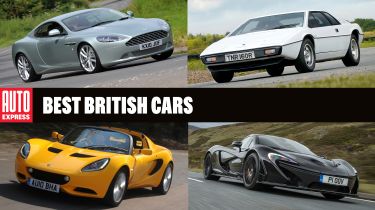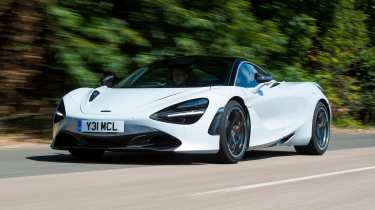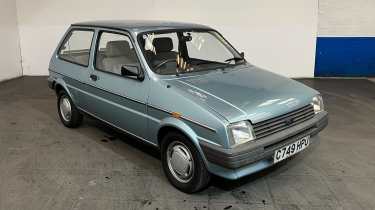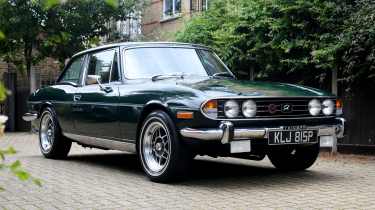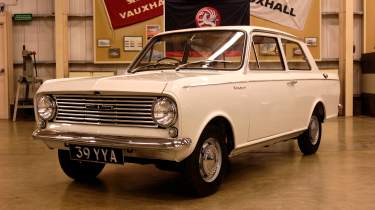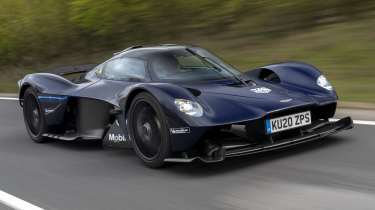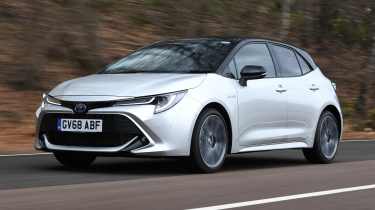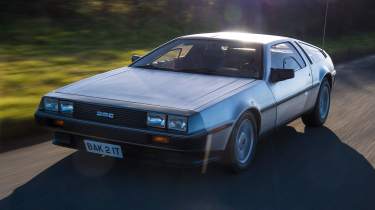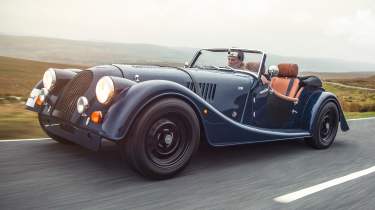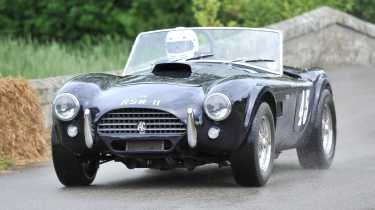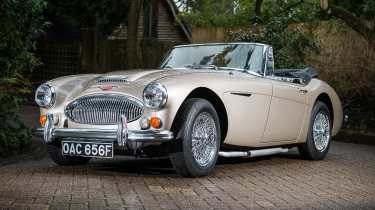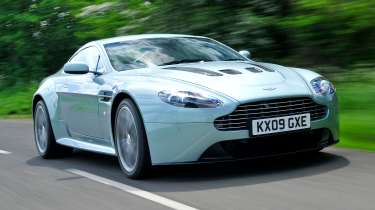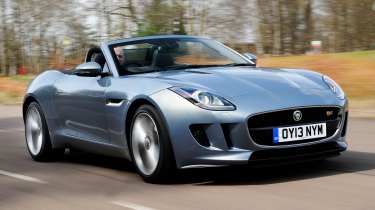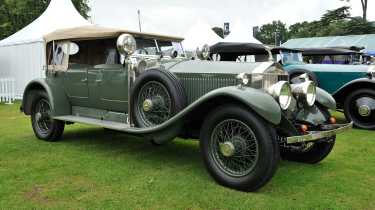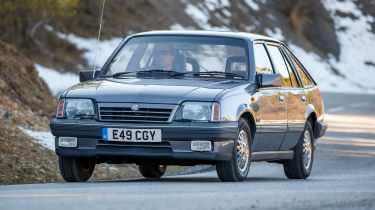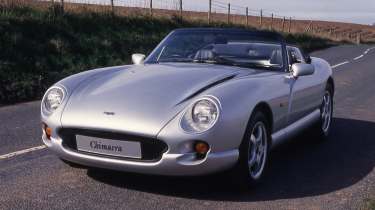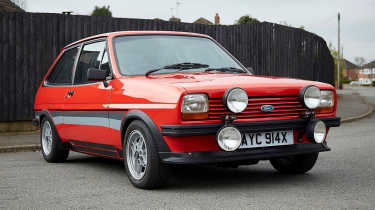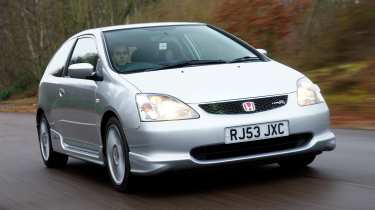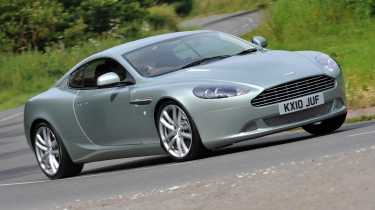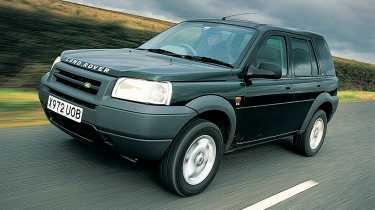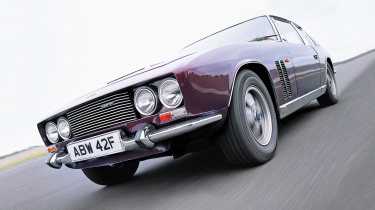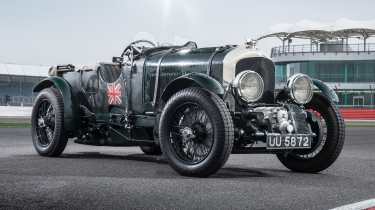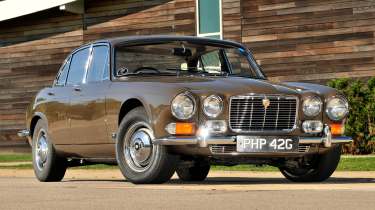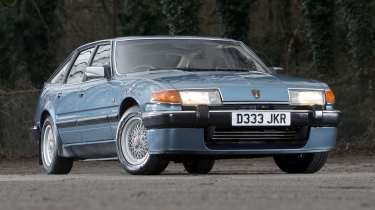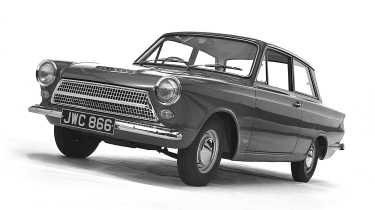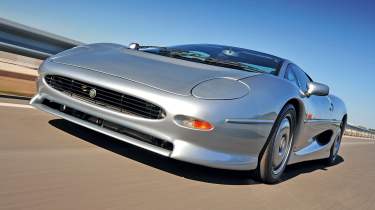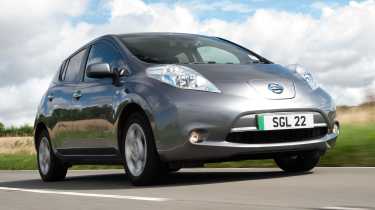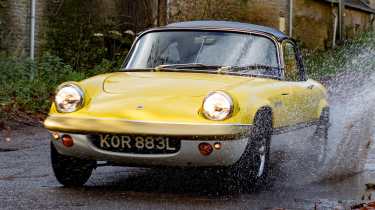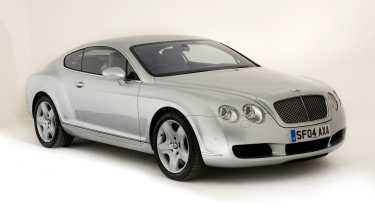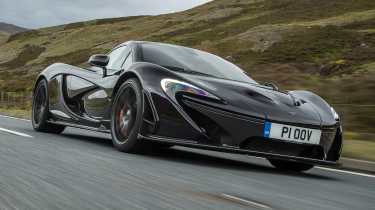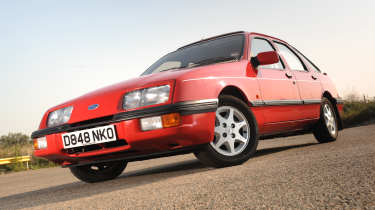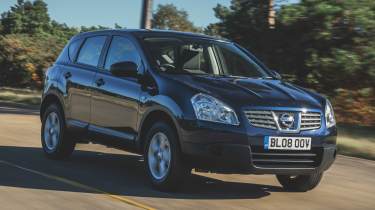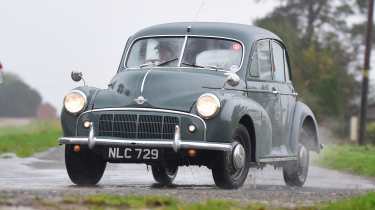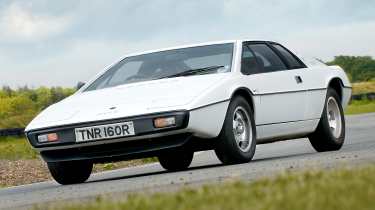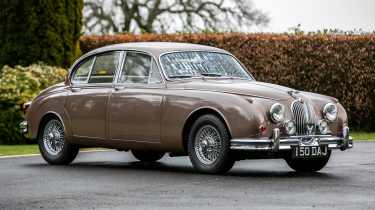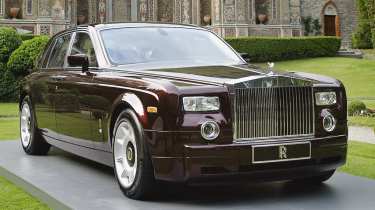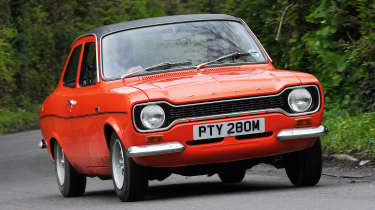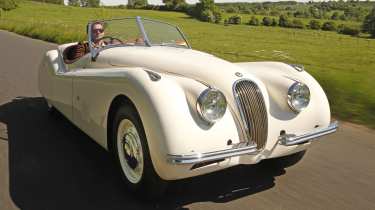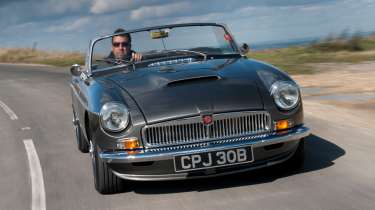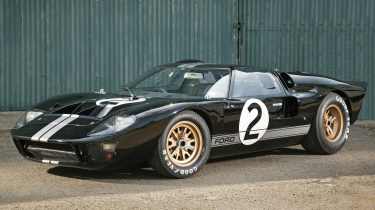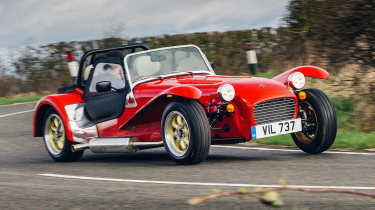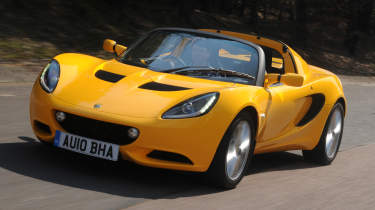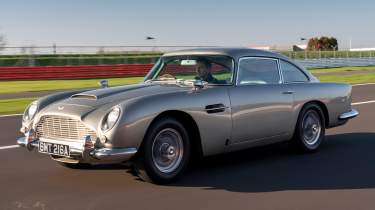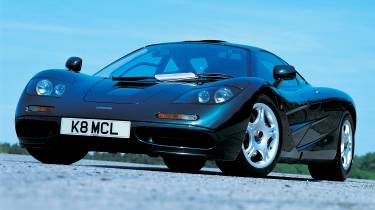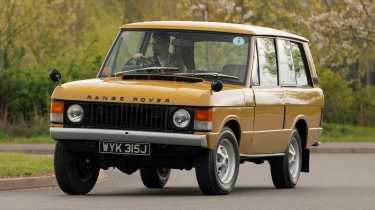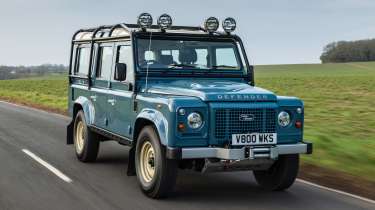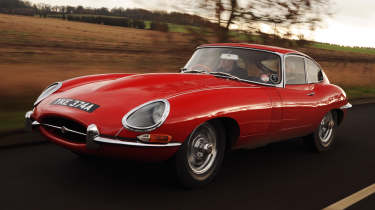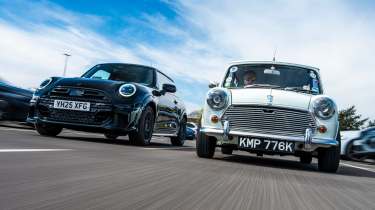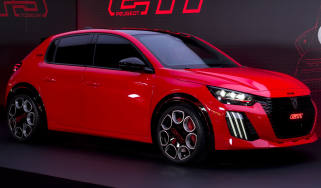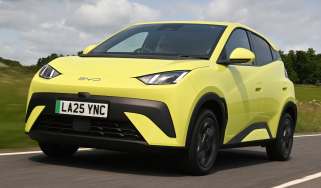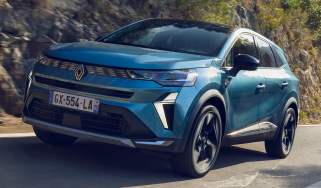Best British cars: Top 50 all-time greatest British-built cars revealed
We're naming our top 50 car models built in the UK over the years. Is your favourite motor among them? Read on to find out
What’s the best British car of all time? The Mini? A Land Rover? Jaguar has made some crackers, and we can’t forget motors from pinnacle manufacturers such as Aston Martin, McLaren, Bentley and Rolls-Royce. Six years after our last ranking, we’ve revisited our Top 50 best British built cars of all time.
All the UK's brands are either foreign-owned or have significant overseas financial backing due to globalisation and the UK’s open economy. But the models listed in our top 50 are united by one key attribute: being made in Britain. That’s why overseas investors Nissan, Ford, Toyota and others have a shot at glory in our Top 50 round-up, too.
To rank them, the Auto Express editorial team took a list of 75 key cars and numbered them from one to 50. Each judge considered them based on their engineering pedigree, design, commercial success, significance in automotive history and the heartfelt emotion each stirred. The placings were then converted into points and amalgamated to decide the final table.
There are some fresh entries since we last compiled the list, so read on for our countdown of the Top 50 best British-built cars of all time. It’s bound to spark plenty of debate; let us know which cars top your list, too.
50. McLaren 720S
- No. built: 7,000 (approx)
- From: 2017-2023
- Price new/now: £208,600/£120,000-£170,000
- Engine: 4.0-litre V8 twin-turbo petrol, 710bhp
- Top speed: 212mph
It’s hard to pinpoint the specific moment when the ‘normal’ series- production supercar reached the point of utterly mad performance, but we’d hedge a bet it might well be the 2017 McLaren 720S.
This all-new model took the not-so-humble supercar to the next level, thanks to a heavily revised 4.0-litre V8 engine, lightweight carbon-fibre structure, state-of-the-art chassis and an eccentric design. In terms of accessible automotive performance, the 720S took what we thought to be million-pound hypercar performance, and packaged it into a usable supercar.
49. Austin Metro
- No. built: 948,893 (A-Series only)
- From: 1980-1990
- Price new/now: £3,495/£2k-£7k
- Engine: 1.0-litre 4cyl petrol, 44bhp
- Top speed: 87mph
Small front-wheel-drive hatchbacks had been popular around the globe since the early seventies, so when the Metro arrived in 1980, it was hardly cutting-edge, especially with its fifties engine. This supposed Mini replacement was ‘a British car to beat the world’, but the Mini outlived the original Metro by more than 10 years.
That didn’t matter, because this ultra-practical hatch was a big success for its maker, which also introduced sporty MG models, including a Turbo edition. There was a Mk2 Metro in 1990, with Rover’s more modern K-Series engine.
48. Triumph Stag
- No. built (UK): 25,939
- From: 1970-1977
- Price new/now: £2,093/£8,000-£25,000
- Engine: 3.0-litre V8 petrol, 145bhp
- Top speed: 117mph
It’s taken a long time for the Stag to be admired; in period it was pilloried by many who loved to nickname it ‘the Snag’, but this stylish convertible with space for four adults always had huge potential. That potential has now been realised; modern know-how means the Stag is more reliable than in the seventies.
When set up correctly, the V8 provides a scintillating soundtrack, and it ensures that this Triumph is a great long-distance tourer.
47. Vauxhall Viva
- No. built: 1,516,792
- From: 1963-1983
- Price new/now: £539/£15,000-£50,000
- Engine: 1.0-litre 4cyl petrol, 44bhp
- Top speed: 80mph
Today, the Vauxhall Astra is as familiar a sight on our roads as double yellow lines. Yet before this popular hatch made its debut in 1980, the Viva was the brand’s top compact family car. Available across three generations from 1963, the Viva was a simple rear-wheel-drive saloon that was easy to drive and cost-effective to run.
Production ended in 1979, but the HA van lasted until 1983 thanks to demand from BT and the Post Office. Vauxhall revived the Viva name in 2015 for its rebadged Chevrolet Spark, but slow sales meant it was killed off in 2019.
46. Aston Martin Valkyrie
- No. built: 275
- From: 2021-2024
- Price new/now: £2m (est)/£3m
- Engine: 6.5-litre V12 petrol, 1,160bhp
- Top speed: 250mph+
Much of the Valkyrie’s tech make-up sounds like fiction, because the numbers are mind-boggling. The Cosworth-developed 6.5-litre V12 produces 1,000bhp (the most powerful naturally aspirated engine ever) and is boosted by an F1-style hybrid system built by Rimac for a combined 1,160bhp, all going to the rear wheels.
The body, designed by F1’s Adrian Newey, has some serious aero, which makes for 3.3G of lateral force in corners in track-only AMR Pro form. It should stand the LMH race car in good stead at the Le Mans 24 Hours race this year.
45. Toyota Corolla/Auris
- No. built (UK): 2,682,990
- From: 1997-present
- Price new/now: £10,995/£1k-£38k
- Engine: 1.3-litre 4cyl petrol, 84bhp
- Top speed: 109mph
For many years the Corolla and Auris were derided as being little more than appliances on wheels, because they lacked character. They weren’t especially engaging to drive, and had bland design inside and out.
But for buyers who just wanted reliable transport and good value for money, these two Toyotas hit the spot perfectly, thanks to their Swiss watch-like reliability and generous equipment levels. Nowadays, the Corolla
packs hi-tech powertrains and it looks sharp – and it’s not half bad to drive, either.
44. DeLorean DMC-12
- No. built: 8,987
- From: 1981-1982
- Price new/now: £16,660/£65,000
- Engine: 2.8-litre V6 petrol, 130bhp
- Top speed: 130mph
The DeLorean DMC-12 is definitely one of the most famous cars ever, but only because of its role in the Back to the Future film trilogy. Built in Belfast, and funded largely by around £84m of UK Government cash, this stainless steel-clad wedge had the aerodynamic qualities of a block of cheddar, and handled about as well as one.
Powered by a 130bhp 2.8-litre V6 developed by Renault, Peugeot and Volvo, it was good for 0-62mph in 10.5 seconds, at least according to its creators. If 0-62mph takes 10.5 seconds, Lord knows how long you’d need to hit 88mph.
43. Morgan Plus 4
- No. built: 4,584
- From: 1950-2020
- Price now: £20,000-£69,995
- Engine: 2.0-litre 4cyl petrol, 154bhp
- Top speed: 118mph
The most popular model in Morgan’s history, the Plus 4 is everything you want from a classic British roadster. Every iteration used a four-cylinder engine, with the ‘Plus’ denoting extra performance over the 4/4 model.
While the current Plus Four has developed into a bit of a sports car (especially with the Dynamic Handling Pack), the old Plus 4 was something you’d take on a leisurely Sunday drive to the pub, while its low weight, revvy engine, steering and rear-driven nature would always provide entertainment. Little wonder that residual values are high for the Plus 4 – you’d do well to find one less than £20,000.
42. AC Ace/Cobra
- No. built: 689 (Ace), 1,137 (Cobra)
- From: 1953-1967
- Price new/now: £2,453/£175k-750k
- Engine: 4.7-litre 8cyl petrol, 271bhp
- Top speed: 140mph
When AC introduced the Ace in 1953, it was one of the prettiest cars around, but it featured the company’s own 2.0-litre six-cylinder engine, which dated back to 1919. So in 1956 AC slotted in a more modern Bristol motor instead, and by 1961 a 2.6-litre Ford Zephyr unit was installed.
But it was in 1962 that things got fruity, when ex-racer Carroll Shelby got an Ace and turned it into the Cobra by fitting a Ford 4.2-litre V8. A 4.7-litre unit followed, but the truly fearsome one is the Cobra 427, with a 7.0-litre V8 and too much power for the AC’s antiquated chassis.
41. Austin Healey 3000
- No. built: 42,816
- From: 1959-1968
- Price new/now: £1,257/£25k-£85k
- Engine: 2.9-litre 6cyl petrol, 124bhp
- Top speed: 113mph
The Austin Healey ‘Frogeye’ Sprite would become a synonym for affordable fun, but five years before that ultra-basic sportster arrived, there was the four-cylinder Austin-Healey 100/4, the first of the ‘Big Healeys’.
This got a more potent six-cylinder engine in 1956 (the 100/6) before morphing into the 3000 in 1959. Fabulously capable in road racing and international rallying, the 3000 was very lucrative for its maker, thanks to huge demand in the US (no 25 per cent tariffs then). There were three iterations of the 3000 produced.
40. Aston Martin Vantage
- No. built (UK): 25,000 (est.)
- From: 2004-2018
- Price new/now: £79,000/£20k-£40k
- Engine: 4.3-litre V8 petrol, 380bhp
- Top speed: 175mph
Staying true to a design concept can be hard, but thankfully Aston Martin kept the wonderful lines of the 2003 AMV8 Vantage concept with its ‘baby Aston’. Penned by Ian Callum and Henrik Fisker, the Vantage project actually started before the DB9, hence why it shares plenty of design traits with its larger sibling.
The Vantage provided the Porsche 911 with some competition, with a characterful 4.3-litre V8 (later upped to 4.7 litres). The highlight came when Aston shoehorned a 5.9-litre V12 into the engine bay to create the majestic V12 Vantage.
39. Jaguar F-Type
- No. built: 87,731
- From: 2013-2024
- Price new/now: £51,235/£15,000-£67,000
- Engine: 3.0-litre V6 petrol, 337bhp
- Top speed: 161mph
Built at Jaguar’s famous Castle Bromwich plant, the F-Type was a return to the company’s glory days of strikingly appealing sports cars.
The Ian Callum-designed two-seater, launched by Jag as a convertible in 2013 before adding a coupé a year later, had a beautiful bark, whether you went for the 5.0-litre V8 or the 3.0-litre V6, both of which were supercharged. The later arrival of a 2.0-litre engine made the Jag more affordable, if less characterful, but all versions are popular.
38. Rolls-Royce Silver Ghost
- No. built (UK): 6,173
- From: 1906-1926
- Price new/now: £998 (chassis only)/£100k-£300k
- Engine: 7.0-litre 6cyl petrol, 48bhp
- Top speed: 60mph
When Rolls-Royce introduced the 40/50HP in 1906, it broke no new ground technically, but it was very refined and reliable. The car notched up a 15,000-mile reliability run that involved driving between London and Pitlochry in Perthshire 27 times in succession. That was done using the silver 12th 40/50HP made, which the firm used for publicity.
It was nicknamed the Silver Ghost, and the moniker would go on to be applied to all 40/50HPs, even though there was only one true Silver Ghost.
37. Vauxhall Cavalier
- No. built: 1,800,000
- From: 1977-1995
- Price new/now: £2,324/ £3,000-£7,000
- Engine: 1.3-litre 4cyl petrol, 75bhp
- Top speed: 90mph
The Cavalier was a company-car favourite across three generations of very different-looking models – and all rolled out of the Luton plant that built its last vehicle in March 2025. The Mk1 saloon was built on the same platform as the smaller Chevette, and while the Mk 2 and Mk3 were more popular as hatchbacks, they were also available as saloons.
The Mk2 came as an estate and convertible, but all were UK motorway mainstays, with reps checking trim levels to see who was a boss’s favourite.
36. TVR Chimaera
- No. built (UK): 5,256
- From: 1992-2003
- Price new/now: £28,950/£14,000-£35,000
- Engine: 3.9-litre V8 petrol, 240bhp
- Top speed: 152mph
These days, the most exciting thing to come out of Blackpool is Strictly Come Dancing, but not long ago it was anything with a TVR badge. The brand is currently on life support and hasn’t produced a car since 2006, but one of its best old-school sports cars was the Chimaera.
Combining V8 performance and exciting rear-wheel-drive handling for thousands less than roadster rivals from Porsche and Mercedes, it was a big seller for TVR. The cutout around the front indicators was the result of boss Peter Wheeler’s dog taking a bite out of the clay model of the prototype. He liked it so much it made it to production.
35. Ford Fiesta
- No. built: 4,800,000
- From: 1976-2002
- Price new/now: £2,114/£3,000-£20,000
- Engine: 957cc 4cyl petrol, 40bhp
- Top speed: 81mph
The Fiesta was huge news when it was introduced in 1976. This was the first Ford sold in the UK with front-wheel drive and a transversely mounted engine, which meant more cabin space and more sure-footed handling. Codenamed Bobcat, the first Fiestas were built in Spain, but Dagenham also produced its fair share.
Unleashed onto the UK market in February 1977, it instantly became a best seller, helped by a steady stream of special edition and go-fast models including the XR2. The Fiesta would rule the new-car sales charts right up to its demise in 2023.
34. Honda Civic
- No. built: 1,600,000
- From: 1994-2021
- Price new/now: £38,690/£2,000-£35,000
- Engine: 2.0-litre 4cyl petrol, 315bhp (2021 Type R)
- Top speed: 168mph
Originally launched as a supermini in 1972, the Civic has grown into a spacious family hatch.
In 1994, the brand’s UK factory in Swindon started producing the fifth-generation Civic alongside the CR-V SUV. More importantly for keen drivers, it became the home of the hot Type R in 2001, exporting the fast and fun hatch all around the world. Unfortunately, the Swindon site was closed in 2021, but not before more than 1.5 million Civics had driven out of its doors.
33. Aston Martin DB9
- No. built: 16,500
- From: 2003-2016
- Price new/now: £103,000/£18,000-£120,000
- Engine: 5.4-litre V12 petrol, 450bhp
- Top speed: 186mph
Modern Aston Martin stands on the bedrock laid by the DB9. When ex-Porsche R&D boss Ulrich Bez joined the firm in 2000, he binned a nascent mid-engined Aston, instead introducing the aluminium VH architecture with the flexibility to sire the V8 Vantage and this gorgeous coupé. Built in Gaydon, Aston’s first purpose-built factory, the smooth grand tourer handled tidily, but it was all about the bellowing, torquey V12. It spawned the Volante, DBS and Rapide offshoots in its 13-year history.
32. Land Rover Freelander
- No. built: 547,920
- From: 1997-2007
- Price new/now: £15,995/£1,000-£5,000
- Engine: 1.8-litre 4cyl petrol, 118bhp
- Top speed: 102mph
Mass-market compact SUVs were in their infancy in the late eighties, but that didn’t stop Rover developing one. Initially called Project Lifestyle, then Pathfinder, and finally Project Oden, Rover had plenty of names but no cash; it took BMW’s purchase of Rover in 1994 for the Freelander to become a reality.
Launched in 1997, the Freelander was affordable and stylish, and despite its entry-level status it was as capable off-road as you’d expect a Land Rover to be. The Freelander II arrived in 2006 and was even better.
31. Ariel Atom
- No. built: 1,800
- From: 2000-present
- Price new/now: £19,995/£30,000-£85,000
- Engine: 2.0-litre 4cyl petrol, 320bhp
- Top speed: 162mph
If you’ve ever wondered what a child’s climbing frame would be like to drive at 100mph, then the Atom is the car for you. Engineered and hand-built in Somerset, the Ariel is now effectively in its fourth generation.
Powered by a variety of powerful mid-mounted Honda engines and with minimal protection from the elements, the Atom delivers a uniquely fast and thrilling driving experience. This is especially true of the 4R which, with its big wings and turbocharged motor, is essentially a racing car for the road.
30. Jensen FF
- No. built: 330
- From: 1966-1971
- Price new/now: £5,249/£45,000-£150,000
- Engine: 6.2-litreV8 petrol, 330bhp
- Top speed: 140mph
The first high-performance road car to feature four-wheel drive and anti-lock brakes, the FF was a true pioneer in 1966. Combining these innovations with a burbling 6.2-litre Chrysler V8 engine, its all-weather pace and poise redefined what was possible for such cars.
So how come so few were sold? Well, at the same time Jensen also offered the visually identical but much less sophisticated two-wheel-drive Interceptor for two thirds of the price. So fashion-conscious buyers went for the cheaper car, which sold 10 times as many.
29. Bentley Blower
- No. built: 55
- From: 1929-1931
- Price new/now: £1,150 (chassis only)/£800,000-£3,000,000
- Engine: 4.4-litre 4cyl petrol, 182bhp
- Top speed: 100mph
The Blower Bentley is such an icon that its maker has recently put it back into production, with 12 cars available at £1.5m apiece. The irony is that the original Blower wasn’t the work of Bentley at all, because company founder WO Bentley hated the idea of forced induction. But that didn’t stop Bentley racer Henry Birkin from developing his own take on the 4.5-Litre, complete with supercharger. His plan was to win the Le Mans 24 Hours with his ‘Blower Bentley’, but sadly it was never to be.
28. Jaguar XJ6
- No. built: 78,973
- From: 1968-1973
- Price new/now: £2,258/£15,000-£20,000
- Engine: 4.2-litre 6cyl petrol, 245bhp
- Top speed: 124mph
‘Creating an exciting new world of luxury motoring’ was the tagline of the Jaguar XJ6 when it was launched in 1968, and for good reason. The debonair saloon replaced four different models in the company’s line-up, and established new standards for comfort and handling. No wonder Jaguar founder Sir William Lyons used it as his personal wheels.
There was a choice of smooth 2.8 or 4.2-litre straight-six engines, while its interior featured endless amounts of wood and leather, plus sumptuous carpet, as you’d expect of a Jaguar.
27. Rover SD1
- No. built: 303,345
- From: 1976-1986
- Price new/now: £4,750/£1,500-£20,000
- Engine: 3.5-litre V8 petrol, 190bhp (Vitesse)
- Top speed: 135mph
An upmarket exec hatchback with looks inspired by the Ferrari Daytona, the SD1 caused a stir when it arrived in 1976. But industrial unrest at Rover’s parent firm British Leyland resulted in appalling quality and reliability – if the car didn’t fall apart on your drive, it would probably break down on the way to work.
Rover soon sorted these niggles and with its sharp handling, smooth ride and roomy cabin, the SD1 became a sales success. It was also a huge hit with UK traffic cops, with various forces stockpiling examples at the end of production in 1986, allowing them to continue to chase crooks until well into the nineties.
26. Ford Cortina
- No. built: 3,155,161
- From: 1962-1982
- Price new/now: £643/£8k-£60k (Mk1)
- Engine: 1.5-litre 4cyl petrol, 60bhp
- Top speed: 81mph
When Ford introduced the Consul Cortina in 1962, it was utterly conventional, but it was also spacious, light and affordable.
It was a smash hit with a new breed of motorists that was emerging: company-car drivers. Families loved it, too, because there was a decent choice of engines and trims, plus saloon and estate bodystyles. The Cortina hit the spot and by the time the model was axed in 1982, there had been five generations of Ford’s family favourite.
25. Jaguar XJ220
- No. built: 282
- From: 1992-1994
- Price new/now: £403,000/£500,000
- Engine: 3.5-litre V6 petrol, 542bhp
- Top speed: 217mph
Featuring stunning looks, a mighty 6.2-litre V12 engine, four-wheel drive, all-wheel steering and a 220mph top speed, the XJ220 brought the 1988 British Motor Show to a standstill.
By the time the production version arrived in 1992, a lot had changed. The trick transmission and steering were ditched, while the V12 was replaced by the twin-turbo 542bhp 3.5-litre V6 from the Group B Metro 6R4 rally car, but its soundtrack and laggy delivery weren’t in keeping with the XJ220’s £403k price. Today it’s rightly regarded as a supercar great, but in 1994 Jag pulled the plug with just 282 sold.
24. Nissan Leaf
- No. built: 270,000+
- From: 2013-present
- Price new/now: £28,350 (2010)/£1.5k-£22k
- Engine: 1x e-motor, 107bhp (Mk1)
- Top speed: 89mph
It might not be the sexiest or most exciting model Britain has ever built, but the Nissan Leaf was the first mass-market electric car, paving the way for today’s sea of affordable EVs. For that reason it deserves our respect.
The Leaf pioneered features such as one-pedal driving and remote charging access across its two generations, with an all-new Mk3 model coming this year. Early examples were built in Japan, but production moved to Sunderland in 2013 and we’re pleased to report that the next-generation Leaf will be made in the same plant.
23. Lotus Elan Mk1
- No. built: 9,153
- From: 1962-1973
- Price new/now: £1,596/£15,000-£50,000
- Engine: 1.5-litre 4cyl petrol, 105bhp (Elan S2)
- Top speed: 108mph
Few sports cars are as engaging and exciting to drive as the original Elan. The brainchild of Lotus founder
Colin Chapman, this light and agile two-seater features exquisitely balanced rear-drive handling, a rorty twin-cam engine and a surprisingly supple ride.
Available as a coupé, roadster and even a 2+2, the Elan was the template for the Mazda MX-5, which is now the world’s best-selling roadster. Lotus revived the Elan name in 1989, but while that car drove brilliantly, the front-wheel-drive layout was kryptonite to enthusiasts and it was axed in 1995, only to be reborn a year later as a Kia.
22. Bentley Continental GT
- No. built: 90,000
- From: 2004-present
- Price new/now: £110,000/£10,000-£224,000
- Engine: 6.0-litre W12 petrol, 550bhp
- Top speed: 198mph
The Continental GT is a phenomenon: by dropping Bentley’s then-price point by £70k and modernising the design and tech, execs turbocharged the firm’s sales sixfold in the GT’s first full year. Suddenly a Bentley was the car of choice for footballers, not aristocrats. The compact W12 engine fused two VW VR6 units and sits further back in the nose, with its 649Nm of torque sent to all four wheels. Three generations on, the mighty W12 has made way for V8 hybrid power with an extra 221bhp.
21. McLaren P1
- No. built: 375
- From: 2013-15
- Price new/now: £886,000/£1m-£1.2m
- Engine: 3.8-litre V8 twin-turbo petrol hybrid, 903bhp
- Top speed: 217mph
Shortly after McLaren’s highly public relaunch into the supercar game, it quickly realised that to gain true notoriety it needed a halo product that could be seen as the successor to the iconic F1, and also envisage the future of supercar tech. Enter the P1, McLaren’s 903bhp hybrid-assisted hypercar that didn’t just offer phenomenal design, performance and driver engagement, but was also the brand’s guiding light for essentially all its models since. Plus it’s the most ambitious of the new-age McLarens.
20. Ford Sierra
- No. built: 3,000,000 (est.)
- From: 1982-1993
- Price new/now: £6,615/£4k-£100k
- Engine: 1.8-litre 4cyl petrol, 90bhp
- Top speed: 106mph
Ford has rarely led the way in engineering, but it has often democratised performance motoring, and the Sierra RS Cosworth, XR4i and XR4x4 are perfect examples of this. But at heart the Sierra became a fleet favourite after a rocky start, when its ‘jelly mould’ body put off many potential buyers. The running gear was conventional; Ford didn’t use front-wheel drive at a time when it was becoming the norm. But after that initial scepticism, drivers couldn’t get enough of the Sierra in all its forms.
19. Nissan Qashqai
- No. built: 4,000,000
- From: 2007-present
- Price new/now: £14,345/£3,800-£27,135
- Engine: 1.6-litre 4cyl petrol, 117bhp
- Top speed: 109mph
There’s no doubt significance can trump outright desirability, and the Qashqai is one of the most significant British motor industry stories of recent times. It’s a car that redefined mainstream motoring when it introduced the concept of a higher-riding hatchback crossover; it exploded in popularity overnight, but it has also had an immeasurable impact on UK manufacturing, thanks to the millions of cars produced by the Sunderland plant.
Now in its third generation, the Qashqai continues to be astoundingly popular with UK buyers, and has proven the efficiency and quality of British car manufacturing.
18. Morris Minor
- No. built: 1,619,857
- From: 1948-1971
- Price new/now: £628/£1,500-£40,000
- Engine: 948cc 4cyl petrol, 37bhp
- Top speed: 75mph
Before he created the iconic Mini in 1959, Sir Alec Issigonis penned the Morris Minor. Affectionately known as the Moggy, it was launched in 1948 and proved an instant hit; in 1960 it became the first British car to reach
the magic mark of a million sales.
Despite its antiquated looks, the Minor had novel independent front suspension and rack and pinion steering, resulting in a decent ride quality and crisp handling. The Moggy died in 1971, but its underpinnings lived on in the rather less impressive Marina.
17. Austin Seven
- No. built: 290,000
- From: 1922-1939
- Price new/now: £135/£4,000-£20,000
- Engine: 747cc 4cyl petrol, 10.5bhp
- Top speed: 45-50mph
Few people could afford a car in the early twenties, which is why motorcycles and ‘cycle cars’ had become so popular. Herbert Austin spotted a gap in the market and came up with a proper car for those on a budget, and the Austin Seven was born.
It was made for 17 years, and there were an incredible 329 variations thanks to independent coachbuilders offering an array of designs, while Austin offered multiple bodystyles. Still popular in historic racing, the Seven is truly the car that put Britain on wheels.
16. Lotus Esprit
- No. built: 10,675
- From: 1976-2004
- Price new/now: £7,979/£30,000-£60,000
- Engine: 2.0-litre 4cyl petrol, 160bhp
- Top speed: 138mph
The Lotus Esprit is another iconic British car that was thrust into the limelight thanks to the James Bond franchise – but a good PR agent isn’t the only reason it’s on this list. For one thing, the Esprit was the very last car signed off by the company’s founder, Colin Chapman. It also challenged Ferraris and Porsches for performance, but undercut them on price.
The original car featured a 2.0-litre four-cylinder engine, while the final iteration was powered by a 350bhp 3.5-litre V6, bolted to the manual gearbox from a Citroen or Renault.
15. Jaguar Mk2
- No. built: 91,222
- From: 1959-1969
- Price new/now: £1,843/£8,000-£70,000
- Engine: 3.8-litre 6cyl petrol, 220bhp
- Top speed: 125mph
The old Jaguar advertising line of ‘grace, pace and space’ could have been coined for the magnificent Mk2. Blending curvaceous good looks with a luxurious cabin and poised driving dynamics, the four-door Jag single-handedly invented the sports saloon sector.
It was powered by the brand’s snarling XK straight-six motor, with the flagship 3.8-litre packing 220bhp for sports car-humbling performance. This made it a hero on the race tracks, yet it was also a villain on the road, as Swinging Sixties’ criminals found the fast and strong big Cat made the perfect getaway car.
14. Rolls-Royce Phantom
- No. built: 10,327
- From: 2003-2017
- Price new/now: £407,400/£40,000-£400,000k
- Engine: 6.7-litre V12 petrol, 454bhp
- Top speed: 149mph
The first Rolls-Royce to arrive after BMW took over ownership of the brand was a huge relief, because it showed the German company knew what it was doing. The Phantom was elegant, utterly luxurious and refined, and a different world to everything outside. Saloon, coupé and drophead convertible bodystyles made for a glamorous trip across 14 years of production, complete with the Series II update in 2012.
When we reviewed it, we said: “There is no other car on the planet that can match the opulence, superlative ride comfort and hushed refinement of this remarkable Rolls-Royce.”
13. Ford Escort
- No. built: 2,036,139
- From: 1968-2002
- Price new/now: £750/£8k-£50k
- Engine: 1.3-litre 4cyl petrol, 58bhp
- Top speed: 85mph
The Escort Mk1 might have been mechanically staid when it arrived in 1968, but it was streets ahead of the antiquated Anglia it replaced. With crisp, modern styling and engines that ranged from mild to wild, there was an Escort for everyone, even racers; it was a huge success on race tracks and rally stages around the globe, and Ford traded on that with sporty road-going models such as the RS Mexico.
It’s a formula that largely succeeded until the end of Escort production in 2002, by which point there had been six generations, including the universally derided Mk5.
12. Jaguar XK120
- No. built: 12,055
- From: 1948-1954
- Price new/now: £1,263/£45k-£150k
- Engine: 3.4-litre 6cyl petrol, 160bhp
- Top speed: 125mph
Many cars have claimed to be the ‘fastest in the world’, but the XK120 was the first production vehicle to officially claim the title. Launched in 1948, the sleek Jaguar was styled by company founder Sir William Lyons and was the first to use the brand’s legendary 3.4-litre straight-six motor, which powered the car to a 124.6mph top speed.
The XK120 also set the tone for the brand’s motorsport success, winning numerous races and rallies, including an RAC Tourist Trophy victory with Stirling Moss at the wheel. In fact, much of the XK’s running gear was used in the firm’s Le Mans-winning C-Type racers.
11. MGB
- No. built: 523,836
- From: 1962-1980
- Price new/now: £849/£2,000-£35,000
- Engine: 1.8-litre 4cyl petrol, 95bhp
- Top speed: 105mph
There are many reasons why the MGB is a huge hit with classic car owners, not least its pert Italian lines and simple mechanicals. Yet the fact it was also a massive success when new means there are still lots to choose from.
Designed to cash in on booming US demand for British sports cars in the sixties, the MGB also sold well at home. The roadster and GT coupé were great to drive, even if the 1.8-litre engine was slightly weak – although this was solved with the 3.5-litre V8 model. A heavily revised RV8 version was introduced 1992, making it one of the first restomods ever.
10. Land Rover Discovery
- No. built: 385,655
- From: 1989-1998
- Price new/now: £15,750/ £1,000-£20,000
- Engine: 2.5-litre 4cyl diesel, 111bhp
- Top speed: 92mph
Today’s roads are jam-packed with stylish SUVs, but without this Land Rover arguably none of them would exist.
Launched in 1989, the Discovery was designed as a ‘lifestyle’ vehicle, blending an off-roader's rugged ability with the practicality and running costs of a family estate. Built on the same platform as the much more expensive Range Rover, the Disco had a cutting-edge direct-injection 2.5-litre diesel motor that delivered punchy performance and fuel-sipping efficiency.
More importantly, it effortlessly blended genuine go-anywhere ability with car-like composure on the road. Other highlights included a brilliant interior that was created in collaboration with Conran Design.
But while the price has increased, the Landie’s reputation for durability hasn’t, with the latest Mk5 models as likely to be exploring a workshop as they are the great outdoors.
9. Ford GT40
- No. built: 105
- From: 1964-1969
- Price new/now: £5,200/£2,500,000
- Engine: 4.7-litre V8 petrol, 306bhp
- Top speed: 164mph
Commissioned by Ford’s US bosses to race under the Stars and Stripes flag and win the gruelling Le Mans 24-hour race, the low-slung GT40 racer was actually designed and built in the UK.
Engineered by Lola boss Eric Broadly from a shed in Slough, the GT40 mixed the best of Britain’s motorsport know-how with an all-American 4.7-litre V8. Tricky handling meant early cars weren’t too successful, but tweaks by US racer Carroll Shelby and British ace Ken Miles turned it into a formidable car, taking four consecutive Le Mans wins between 1966 and 1969. Ford revived the iconic design for the GT road car in 2005, then made an all-new GT40 in 2016 that took a class win at Le Mans that year.
8. Caterham/Lotus Seven
- No. built: 2,477 Lotus, 22,000 Caterham
- From: 1957-present
- Price new/now: £1,157/£15k-£80k
- Engine: 1.2-litre 4cyl petrol, 34bhp
- Top speed: 80mph
Perhaps the most copied car ever made, apart from the AC Cobra, the Lotus Seven emerged in 1957 and almost 70 years on it’s still in production, courtesy of Caterham. Much has changed over the decades, but the driving experience that’s more akin to riding a fast sports bike, without the worry of tipping over, certainly hasn’t.
Lotus founder Colin Chapman’s maxim was to ‘just add lightness’, and that’s what the Seven was all about. It was basic, so cheap to buy as well as to run, with plenty of performance available even when there wasn’t much power. It was no wonder enthusiasts flocked to buy Chapman’s kits; they’d build their car in a few days and go racing at the weekend. Under Caterham’s stewardship prices have risen, but so have the performance and quality, so today’s Seven is a far cry from the fifties original.
7. Lotus Elise
- No. built: 35,124
- From: 1996-2021
- Price new/now: £8,950/£15,000-£55,000
- Engine: 1.8-litre 4cyl petrol, 118bhp
- Top speed: 126mph
The Elise may well be the pinnacle of the Lotus philosophy – and among the last great attainable cars for the lightweight, nimble connection it offers between driver and machine. The stripped-back two-seater started life in the mid-nineties with Rover K-series power, and although 118bhp sounds like nothing special, it made for a thrilling drive in a car weighing 725kg.
Five years later, the Series 2 replaced the Rover engine with four-cylinder Toyota unit. But even from the Series 3 in 2011 to the very end of production 10 years later, the basic allure was retained and the Elise rightly remains a favourite to this day.
The sub-£20,000 price tag rocketed during the 25 years the Elise was in production, with the final cars costing
more than £45,000. However, that still represented a lot of car for the money.
6. Aston Martin DB5
- No. built: 1,059
- From: 1963-1965
- Price new/now: £4,248/£300,000-£1,000,000
- Engine: 4.0-litre 6cyl petrol, 282bhp
- Top speed: 145mph
If there is such a thing as the most famous car in the world, then the DB5 is in with a shout of claiming the title. As the tricked-out company car of fictional debonair spy James Bond, the Aston Martin has become instantly recognisable to generations of film fans. Yet despite its glamorous reputation and sophisticated image, the DB5 is actually little more than a clever update of its predecessor, the DB4 Vantage. In fact, apart from a slightly larger 4.0-litre straight-six engine with 282bhp that was mated to a new ZF five-speed manual gearbox, the two cars were largely identical. That said, at twice the price of the even more eye-catching and equally quick Jaguar E-Type, the Aston was not a big seller. Still, the DB5’s appeal has never dimmed, and when the brand produced
25 brand-new ‘continuation’ versions in 2020, they all sold out despite an asking price of a cool £2.5 million.
5. McLaren F1
- No. built: 108
- From: 1992-1998
- Price new/now: £540,000/£22m
- Engine: 6.0-litre V12 petrol, 618bhp
- Top speed: 241mph
We feel pretty confident in saying that in terms of British high-performance design and engineering, there’s no more important single model than the iconic McLaren F1.
This world-famous hypercar was created by legendary F1 engineer Gordon Murray and designed by Peter Stephens in a collaboration that pushed automotive technology to the absolute limit. McLaren’s F1 is often noted by a few obvious elements, such as its three-abreast seating, 241mph top speed or shrieking V12 engine, but its undoubted majesty goes considerably further than that.
While this was one of the first road cars to use a carbon-fibre tub-style construction, its level of weight saving went far beyond anything of the era. Also, its incredible performance figures weren’t just the result of brute force, but were derived from the obsessive nature that went into every single element – an unambiguous showing of the talent that Murray instilled in his team.
4. Range Rover
- No. built: 1,000,000+
- From: 1970-now
- Price new/now: £2,000/£105,675
- Engine: 4.4-litre V8 petrol, 523bhp
- Top speed: 155mph
Along with the Jeep Wagoneer of the sixties, the Range Rover really helped lay the groundwork for the modern SUV. Today’s version occupies a role as the definitive luxury SUV, but it was originally developed as a workmanlike vehicle with a wash-down interior – and for the first 12 years of its life it had only three doors.
The original Range Rover, which became known as the Range Rover Classic when the second-generation P38 model arrived in 1994, had a 26-year production run and was updated throughout its life in response to its growing popularity within the luxury segment, especially in North America, culminating in the ‘In Vogue’ and ‘Vogue’ editions.
One thing the Range Rover has always come with is a V8 engine, whether that be from Rover, Jaguar or BMW, but now there’s also the option of diesel, mild-hybrid and plug-in hybrid power. Very soon the Range Rover EV will be launched, too – ensuring we’ll see this icon live well into the future.
3. Land Rover Series/Defender
- No. built (UK): 2m+
- From: 1948-2016
- Price new/now: £300/£4k-£200k
- Engine: 2.5-litre 5cyl diesel, 122bhp
- Top speed: 98mph
The Series Land Rovers, and latterly the Defender, were masters of their many crafts. If you were to commission a drawing of the English countryside or even a swanky London street, chances are a Land Rover Defender would sneak in there somewhere, going about its business as an obligatory piece of farmer’s equipment or a fashion accessory.
You could always count on the cars’ off-road ability, which is no surprise because the Series Land Rovers and Defender also made their name in far more dangerous and explorative fields. In the first decade of production, 70 per cent of Series 1 vehicles were exported, going to 150 countries – including many inhospitable places.
2. Jaguar E-Type
- No. built: 72,528
- From: 1961-1974
- Price new/now: £1,934/£25k-£250k
- Engine: 3.8-litre 6cyl petrol, 265bhp
- Top speed: 150mph
When the E-Type was unveiled at the 1961 Geneva motor show, it caused a sensation. Here was a car that could do the thick end of 150mph for less than two grand, making it either much faster or significantly cheaper than all of its rivals – or both. The thing was, none of those rivals could match the E-Type’s sleek looks, which were an evolution of the D-Type’s – a car created to win the Le Mans 24 Hours. Aerodynamically efficient, gloriously curvaceous and with a bonnet that went on forever, the E-Type would become one of the defining cars of the sixties.
The first E-Types featured a 3.8-litre six-cylinder engine along with independent suspension front and rear for excellent handling with a comfortable ride, a disc brake at each corner for brilliant stopping power, and rack-and-pinion steering. Unsurprisingly, the svelte Jaguar went down a storm and later on we’d get a 4.2-litre engine, a family-friendly 2+2 coupé, then a 5.3-litre V12 from 1971, by which point the E-Type had become more of a grand tourer. But it was still as desirable as ever.
1. MINI/Mini
Morris Mini (1959)
- No. built: 5.3 million
- From: 1959-2000
- Price new/now: £497 (1959)/£15,000-£30,000
- Engine: 848cc 4cyl petrol, 33bhp
- Top speed: 75mph
MINI Cooper (2025)
- No. built: 123,550
- From: 2024-present
- Price new/now: £25,265
- Engine: 1.5-litre 3cyl turbo petrol, 154bhp
- Top speed: 140mph
There was only ever going to be one winner of our Top 50 Brit cars rundown. In a completely unanimous vote from the Auto Express editorial team, the Mini (or MINI, as it is now known) was crowned undisputed champion after a short and somewhat snappy group discussion in the board room at AE Towers.
Put simply, we reckon no other British-built vehicle better represents the relevant, innovative and pioneering UK automotive industry quite like the world’s original small car.
Launching his vehicle at the height of a fuel crisis back in the late fifties, now legendary designer Alec Issigonis was tasked by the British Motor Corporation (BMC) with delivering a sub-three-metre compact car that could carry a family of four. For context, a modern MINI is almost 90cm longer, and arguably not as effective at the job the original was designed to do.
Yet Issigonis’s creation wasn’t quite the overnight success its makers had hoped it might be. Perhaps the British car-buying public was too conservative, or too used to uninspiring three-box saloon cars such as the Ford Anglia or Rover P4 to be tempted by something so forward thinking. It wasn’t until the Mini was commandeered by celebrities and racing drivers that its popularity soared.
One such racing driver was John Cooper, who saw the model’s potential from the start, modifying an original Mini before taking it to victory in various events, including the Monte Carlo Rally four times on the trot. It’s his name that adorns the modern three-door hatchback you see here, as well as souped-up versions of the firm’s superminis and family SUVs.
While more than 5.3 million original Minis were built at the firm’s Oxford site between 1959 and 2000 (1.6 million sold in the UK), the modern MINI as we know it (launched in 2001) has cemented itself as a cult classic. Plans to build the new electric MINI in the UK may have been paused, but in excess of 1,000 cars are currently built in Cowley daily, equivalent to one every 67 seconds.
There really can be little doubt – the Mini (not forgetting the modern-day MINI) truly is the best car this green and pleasant land has ever built. Long may it continue.
Do you agree with our picks for the best British-built cars of all time? Let us know your thoughts in the comments section and check out our used MINI deals below...
Used MINIs on Auto Express

2021 Lexus
UX 300e
25,972 milesAutomaticElectric
Cash £14,600
2022 Mercedes
CLA
21,157 milesAutomaticPetrol1.3L
Cash £23,500
2023 Land Rover
Discovery Sport
36,613 milesAutomaticDiesel2.0L
Cash £27,500
2023 Kia
Sportage
55,816 milesAutomaticPetrol1.6L
Cash £19,500
2023 Tesla
Model 3
19,927 milesAutomaticElectric
Cash £22,300
2025 SEAT
Ateca
54,890 milesManualPetrol1.5L
Cash £13,400
2024 Volkswagen
Golf
45,278 milesManualPetrol1.5L
Cash £13,900
2022 Kia
e-Niro
24,149 milesAutomaticElectric
Cash £14,300
2023 Hyundai
Kona Electric
50,854 milesAutomaticElectric
Cash £13,300
2019 Toyota
Aygo
53,646 milesManualPetrol1.0L
Cash £6,700
2021 BMW
X3
16,484 milesAutomaticDiesel2.0L
Cash £29,400
2023 Kia
Sportage
45,940 milesAutomaticPetrol1.6L
Cash £20,200
